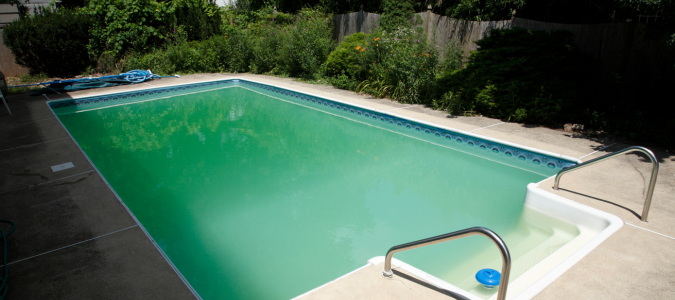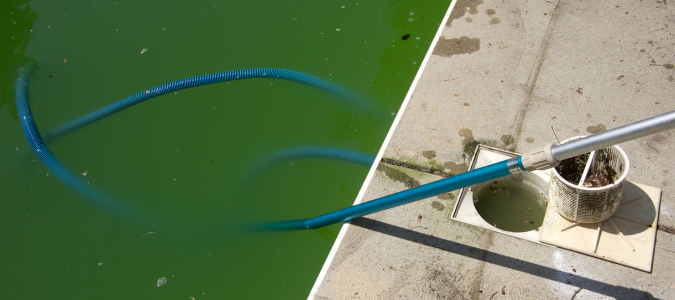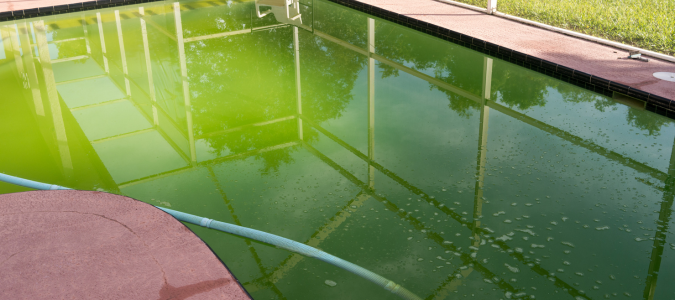Algae can grow in your pool overnight. If you’re lucky, it may only be a green film on the surface. Even that requires several steps to clear properly. If you’re not so lucky, you may be in for a lot more of a challenge to reclaim your hideaway.
Algae are plants. They don’t have much in common with land plants except that they use photosynthesis. Multi-cellular forms of algae are known as seaweed. The algae that invade your pool are single-cell forms. One of the problems with the algae in your pool is they sometimes harbor bacteria.
Algae are everywhere. They can travel by wind, colonizing any water they happen to land in. They can also fall in raindrops. Algae also cling to objects, so swimsuits, pool toys, and even your dog can bring algae from a swimming hole (or a mud puddle) straight to your pool. Algae from the ocean or saltwater pools can also grow in your pool.
Finding algae in your pool is nothing to take lightly, and if your treatment measures aren’t sufficient, it will start right back up. Contacting a pool specialist to deal with an algae bloom is often the best choice.
Pool Maintenance: An Ounce of Prevention
Pool maintenance routines are designed to keep algae at bay. If the water isn’t maintained just right, algae will take advantage of the opportunity and begin to grow. That’s why you need to check the water balance often to make sure the parameters are all in the correct range:
- pH: 7.4 to 7.6
- Alkalinity: 100 to 150
- Calcium hardness: 175 to 225 for plastic and above-ground pools and 200 to 275 for plaster or concrete pools
- Chlorine: 1 to 4 ppm
- Bromine: 3 to 5 ppm
- Biguanide: 30 to 50 ppm
- Salt Water or Mineral System Pools: 0.5 ppm of chlorine
A regular shock of the pool can also help keep your pool’s chemistry where it should be. Creating and keeping a schedule for pool maintenance can head off many water problems during the season.
When Pool Maintenance Isn’t Enough
Things like a particularly hot day or heavy rain shower can throw your pool’s chemistry out of balance. A windy day that blows many leaves into your pool can also mess the water up enough to open the door for algae, and leaves can even bring algae. Heavy usage has also been known to throw off the water balance.
If everything is working as it should, shocking the pool is one of the things that homeowners can usually handle. Once something goes wrong, though, it can be tough to handle on your own.
It often makes sense to bring in pool professionals to deal with an algae bloom. This is especially true if it’s caused by an event that caused a sudden shift in your pool’s chemistry.
The first problem is clearing the algae itself. Depending on the type of algae you’re dealing with, making sure you completely remove it can be challenging, and failure to treat it means it may come right back.
Once you’ve scrubbed the algae out of everything, returning the water balance to normal can be more complicated than usual. Shocking the pool can affect the hardness of the water. Adjusting the pH affects the alkalinity. Change the alkalinity, and you can reduce the free chlorine. A cloudy pool after shock points to new problems with hardness and alkalinity. Together, they all make up a dance of getting your pool’s chemistry right. Getting them back in step can be frustrating and time-consuming. Bringing in a swimming pool contractor is the best way to maintain the health of your pool and keep it free from algae.
Types of Pool Algae
Different types of algae present different problems for pool owners. Some are much easier to treat than others. Knowing what kind of algae you’re dealing with can help you decide how best to proceed.
Yellow Algae
Slow-growing yellow or mustard algae can appear as yellowish-green clouds around a pool’s edges. You’ll also find yellow buildup on pool walls, steps, and ladders. Yellow algae can almost look like sand has been spilled in pool areas.
Yellow algae commonly reach your pool by piggybacking on organic matter like leaves, insects, and twigs.
To eliminate it:
- Remove any organic matter from the area around your pool.
- Scrub everything, including the tools, toys, and anything else that has come into contact with it.
- Shock the pool hard, as high as 20 ppm, and hold the level there for a full day. Liquid chlorine typically works better than the granular form for this.
- During that time, brush and sweep the pool area again to dislodge any algae and get it floating so the filter can catch it.
- Backwash the filter.
- Balance the water.
If it takes a few days for the sanitizer levels to return to normal, that’s fine. Consider those days as insurance against the algae returning.
Black or Blue-Green Algae
Out of the most common algae forms, black algae is the worst for pools. You should suspect a black algae infestation if you notice black or blue-green dots on the walls or bottom of the pool. Black algae don’t hang around much in the open water. Instead, black algae put down roots digging into plaster, mortar, or concrete. Left unchecked, these roots will cause physical damage to your pool, so you could have to resurface it. These algae don’t cling as well to plastic pools.
Eradicating black algae is a challenge. As it’s not a true alga, algicides won’t affect it. Here are the steps to clear your pool of black algae:
- Scrub the pool surfaces.
- Plastic surfaces are easier since the roots can’t penetrate, but affected surfaces must be scrubbed with a soft plastic brush to remove any trace of the colonies thoroughly.
- Concrete, mortar or plaster surfaces require scrubbing with wire brushes or pumice stones to ensure the roots are removed as well as possible and any remaining traces are exposed to the sanitizer.
- One trick is to directly rub the scrubbed pool surfaces with chlorine tablets to remove any remaining roots.
- Ladders, toys, skimmer nets, and anything that might have come into contact with the infected pool must be scrubbed.
- Shock the pool heavily; up to 20 ppm.
- Balance the pool water again.
- Run the pump continuously for a few days and scrub repeatedly to filter out the free-floating algae.
More than any other type of algae, black algae has a season of sorts. It grows best in a low-oxygen environment. If your sanitizer isn’t at full strength during the dog days of summer, black algae can get a start in your pool. Black algae are not something for a homeowner to tackle alone. Bring in a swimming pool contractor if you suspect black algae is taking hold in your pool.
Pink Algae
Less common than the others, pink algae is actually a bacteria rather than algae. The pink slime you see is actually a covering for white water mold. It is more common in plastic or above-ground pools and hot tubs. It grows in darkness and has an affinity for PVC piping. That means you can have pink algae without knowing it.
Eliminating pink algae isn’t easy, but follow these steps to get started:
- Pink algae is likely in your filter, so begin by backwashing your filter.
- Then, shock your pool with free chlorine levels up to 12 ppm.
- Balance the pool water.
- Keep the pool pump running for the next few days, and scrub the pool surfaces often to knock loose any dead organisms. Pay special attention to lights, skimmers and other areas of relatively slow-moving water.
As with black algae, algicides won’t work since pink algae is actually a bacteria.
Green Algae
This is far and away the most common pool invader. It’s exactly the same algae you see forming deep green mats on stagnant ponds. Your pool probably won’t look that bad unless you haven’t touched your pool in a long time. Homeowners are more likely to see a green haze on the water’s surface, or the pool water may be green. Green algae adhere to the sides of the pool, ladders, and steps and make them slick, so it can be a physical hazard and an unattractive nuisance.
How To Get Rid of Green Algae in Your Pool
It’s a safe bet that if your pool is green, something is lacking in its maintenance routine. Green algae love water with a higher pH and lower chlorine than normal. To deal with a green algae invasion, follow these steps:
- Shock your pool as you normally would.
- You can apply an algicide if you wish.
- Balance the water, making sure to bring the pH down to 7.2 or 7.4.
- Run the pump continuously for the next few days.
- Sweep and scrub the pool several times to dislodge any algae that have adhered to something.
Copper: The “Other” Green Water
It’s worth noting that in some rare cases, your pool water could have turned green because of copper. However, that is rare. Algicides more commonly cause it. If you shock your pool and follow up with an algicide, the chlorine can attack the algicide, and green copper oxide is the result. A similar situation can occur from using iron-based chemicals in association with chlorine. The result then is dark brown water. If this happens, you can use a pool flocculant to cause the metal particles to clump together and sink to the bottom of the pool. Then, the pump can pick them up and filter them out.
Green algae are the most common and easiest algal bloom for pool owners to deal with. Even green algae can present problems, though. Certainly, the best treatment is prevention. Establish and keep up with a maintenance schedule. Your pool may need extra monitoring after heavy rains, parties, large amounts of leaves or lawn clippings winding up in the pool, and anything from another pool, swimming hole, or ocean without being thoroughly washed first.
It’s a lot to keep up with. Having a pool can be great for the family, but not if it eats your time or is constantly down for some reason. The expertise of a swimming pool contractor can minimize your pool’s downtime, so you can get back to enjoying it with your family.
ABC Can Keep Your Pool Clean
Contacting a professional pool cleaning and repair service is the best way to eliminate any type of algae in your pool and prevent it from coming back. You can try to get rid of it on your own, but it demands more time and effort than many homeowners have. ABC Home & Commercial Services pool professionals can handle swimming pool cleaning and effectively remove algae. Save yourself time and hassle by contacting us when algae in your pool become a problem.


